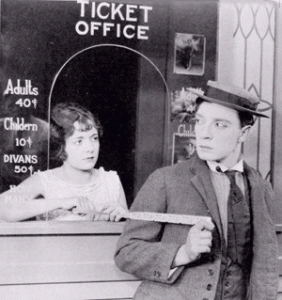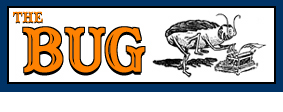 Our hero came from Nowhere– he wasn’t going Anywhere and got kicked off Somewhere. –Opening title card from Keaton’s short, “The High Sign”
Our hero came from Nowhere– he wasn’t going Anywhere and got kicked off Somewhere. –Opening title card from Keaton’s short, “The High Sign”
Did you know that Buster Keaton broke his neck making Sherlock Jr.? This sublime picture (screening this weekend at the equally incredible Tryon microcinema at 7:00 and 9:00 pm–some shows are sold out, so check for availability) includes a film-within-a-film, a deadly billiards game with an exploding 13 ball, love lost and regained, and Buster getting tossed off a train by a violent spray of water. That’s how he broke his neck–falling off a boxcar head-first onto an iron rail. Literally a break-neck movie.
This was nothing for Keaton. As a baby, barely six months old, he tumbled down a flight of stairs, laughing all the way. This prompted none other than Harry Houdini to say “he’s a little Buster”, and the name was born. Keaton’s folks were big on the vaudeville circuit, and hauled the boy with them to shows. The kid tried to walk on stage numerous times, so a stagehand locked him in a chest, almost suffocating the poor child. All of four years old, Buster got his finger crushed in a clothes wringer, had a brick fall on his head, and was blown out of his parents’ hotel room by a tornado, which lifted him a city block away and deposited in the middle of the street, unharmed.
Everything in that last sentence happened on the same day. Or none of it happened at all.
Well, we know that Joseph, aka Buster, Keaton lost his finger in an old-fashioned clothes wringer, and if not there, somewhere, because we can see the stub of an index finger on his right hand in all his films. We’re pretty sure Houdini didn’t nickname young Joe Keaton, but the family were very close with the famed escape artist. Then there are these more pressing concerns: Why didn’t he ever smile? Was he abused? Hailing from a vaudeville family, forever on the road (and, at one point, literally running from the authorities for violating child-labor laws), enduring incredible onstage violence and loving every minute of it or, in the eyes of sympathetic detractors, unable to smile for the hell he endured as a boy. All I can say is: watch the movies.
Keaton’s biographers have a rough time coming to the bottom of the mystery of the Great Stone Face. I’ve read four of them myself, from Rudi Blesh’s fawning and melancholy Keaton; to Marion Meade’s overwrought and damning Buster Keaton: Cut to the Chase (which takes great leaps in logic to conclude that he was illiterate, and less leaping to conclude that he was horribly abused, though I don’t agree); to Keaton’s own fun-filled My Wonderful World of Slapstick (really a blast to read, but it reveals nothing); to Edward McPherson’s slim little volume called Buster Keaton: Tempest in a Flat Hat, which culls a lot of material together and comes to the conclusion that the real Buster Keaton was a… mystery and that you should, uh, watch the movies.
Legend has it that the young Keaton was in New York City, working diligently in vaudeville (for which had been performing since he was four years old, literally) when he came across a pal of his, some other stage man, walking with Roscoe “Fatty” Arbuckle, one of the young stars in this newfangled thing they called movies. The pair invited our hero to watch the filming of one of Fatty’s shorts, “The Butcher Boy”, and Keaton agreed. At the set, they invited Buster to act in a bit part, and he was so good at taking a bag of flour in the face they invited him back. Keaton agreed so long as he could take a camera home and study it–which he did, taking it apart piece by piece. I like to imagine Keaton having a sleepless night, pondering over all of the incredible things he could do with a movie camera–the edits, the special effects, etc.
Next day, Keaton had quit vaudeville forever to join Arbuckle, and in a very short amount of time had started his own production company and made a series of fun and amazing little shorts that get better as his talents improve, and which lead to what was perhaps the greatest string of feature comedies in motion picture history: Our Hospitality, Sherlock Jr., The Navigator, Seven Chances, Go West, Battling Butler, The General, College, and finally, Steamboat Bill Jr. Every one a classic. And by that I mean that if one shows up in your town it is absolutely the best movie playing. So there.
That run ended when Keaton’s studio crumbled under the weight of The General (a flop) and Steamboat Bill (another flop–holy crap, what were audiences thinking those years?!) and he would make just a few more movies for MGM, including a decent one, The Cameraman (though it pales compared to the aforementioned list). Steamboat was the last film over which Keaton had complete creative control. He descended into alcoholism and bankruptcy, bopped around for a few years writing cheap gags for MGM before he found a woman who would help keep him sober, and was lionized in television and in Europe (where else) in his later years.
I honestly don’t know how influential his work has been. More people point to Chaplin as the great comic of the silent era, and I see his effect, good and bad, in comedy today. Battling Butler–usually called Keaton’s weakest, though I love it–influenced Scorsese’s Raging Bull. But I don’t know anyone who’s dropped a train into a ravine, like Keaton did in The General. Sherlock Jr. influenced Woody Allen’s The Purple Rose of Cairo and that Schwarzenegger dud, The Last Action Hero. That’s not much of an influence.
Personally, I don’t know if Keaton was abused or secretly telegraphing his homosexuality or Republicanism or a past life as a serial killer with that Stone Face. As I said, the mystery of Buster Keaton is perhaps understood (as best we can) in his movies. There is an incredible joy in his films, a love of history and machines (including a connection between the 19th and 20th centuries in his historical films that remains unmatched in movies, and he was one of the few silent comedians who edited and directed with an eye toward storytelling, as opposed to simply filming an act), and, perhaps most modernly, an almost existential resolve in every Keaton movie, the look without a smile that seems to accept life as it is, in all its bleak glory.
Often, his films are simply amazing to see, and not very funny, really. Some leave you with a bit of a queasy feeling, like in “Cops” where he not only fails to get the girl, fails to elude the police, but closes with a drawing of a tombstone that reads “The End” with his signature porkpie hat. Or in “The Boat”, where his shipwrecked family walks into a wall of darkness as empty as anything in a Jean-Pierre Melville noir, with Keaton admitting to his stunned wife that he hasn’t the faintest idea where they’re going.
So we know that there was this man who was trained since birth to topple over backwards, to take a broom to the head, and other sweet abuses, who was fascinated trains and engines of all kinds, was interested in American history, (not to mention loving and being loved by women), and who was in the right place and the right time to make beautiful movies that are funny (intended) and quite profound (perhaps not intended). We don’t know if he really was the product of a life in hell or heaven, but watching his movies is heaven, that’s all I can say.
Over the next three weekends you have an opportunity to experience some of this great filmmaker’s finest movies–my favorite of the bunch is The Navigator, though Sherlock Jr. is truly mind-bending and Seven Chances could be the funniest of this lot. Thanks to Barry Kryshka of Take-Up for this opportunity, for the Trylon, and for bringing in Dreamland Faces to play, which is exactly how you should see a silent comedy–with live music. In the dark, with 49 other souls.
Keaton’s mystery and majesty will unforld before you, as a signing saw and according give ryhthm to his onscreen exploits. I guarantee that when you see Keaton fall, tumble, get chased by rocks, almost blown up, almost drown, and almost get run down by thousands of eager women–without a stuntman to take the blows, one of which broke his precious neck–you won’t believe your eyes. What more do you want from the movies?
